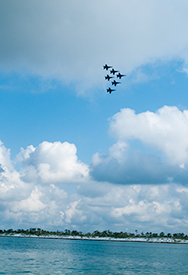Diving at Gulf Islands National Seashore
This National Seashore stretches from the western panhandle of Florida to eastern Mississippi and is comprised mainly of barrier islands and nearby waters. Not surprisingly, this park has a bit of a split personality divided as it is into two widely separated districts, with Alabama islands lying in between but outside the park boundaries.
Barrier islands of sand dunes present a diverse and unique environment. They are dynamic, constantly rearranging themselves at the whim of wind and wave. The bays or sounds formed between them and the mainland often provide sheltered habitat for species that live both in shallow estuaries and in deep sea. Similar environments are preserved by the National Park Service in such places as Padre Island, Texas; Cape Hatteras, North Carolina; and Fire Island in New York.
Gulf Islands National Seashore includes an area on the mainland called Naval Live Oaks, located directly north of Santa Rosa Island. Established when John Quincy Adams was president, this is one of the first natural preserves set aside by the U.S. Federal Government. Although the purpose was to maintain a supply of prized live oak for use in construction of navy ships, not to make a park, it set an early and effective precedent in preserving a natural resource.
BASICS
Location: Islands off Gulf Coast of Florida and Mississippi
Skill level: Intermediate
Access: Boat
Dive support: Pensacola and Gulf Breeze, FL
Best time of year: April-October
Visibility: Florida: good; Mississippi: poor
Highlights: Wreck in the Florida islands, warm waters in summer
Concerns: Tidal currents
Rules and Regulations
Dive Overview
Seaward of the barrier islands are conditions some divers liken to a submerged desert. The water is clear and the white sands are beautiful, but, they maintain, there is not much to see. Focus on small critters in the sand or wait for large pelagic denizens to happen by-it's still nice diving. The most action will, of course, be around jetties and seagrass stands and wrecks on the inside, or "sound side," of the barrier dunes. You can drive to many of the dives; for others you will need a boat.
There are dive shops in Gulf Breeze and Pensacola, and logistics are easy for diving. The Florida Unit of the park and associated sites outside the park are worthy destinations, not just "drop-ins." The Mississippi unit belongs in the latter category, with limited access, poorer visibility, and less interesting dives.
Dive Sites
FLORIDA ISLANDS
Off the northwest corner of the Fort Pickens seawall and the extreme eastern portion of Perdido Key are extensive rock jetties. The rocks attract fish and the drop-off here makes it the quickest and most convenient entry point for scuba divers. Snorkeling is good too. This site is subject to tidal currents because it lies near the channel between the key and Santa Rosa Island.
The wreck of the Sport, an old supply boat, sticks out of the water a hundred yards east of the second parking lot on the sound side. The water is quite shallow here and makes for an excellent snorkel dive.
The wreck Kathleen sits in less than 20 feet of water on the Gulf or seaward side of Pensacola Beach.
The old pilings of Engineer’s Dock are visible from the road on the left side just beyond the park entrance. The water gets about 15 feet deep.
The USS Massachusetts is not to be missed by those interested in shipwreck or military history. Located 1.5 miles outside of the Pensacola Pass in the Fort Pickens State Aquatic Preserve, it can be reached only by boat. The old battleship was sunk here for target practice in 1921 and is easy to find because its main gun turrets are usually awash. Water depth is 26 feet. Water visibility is not the best, but the State of Florida has mapped the wreck and has informational brochures on the site to help guide you around.
MISSISSIPPI ISLANDS
Members of the SRC have never dived the Mississippi portion of the Seashore. Park staff assures us that we haven't missed much because it's hard to get to and visibility is usually poor, particularly on the shore side of the islands, due to the effluent of the muddy Mississippi.
We doubt there'd be much to see even if visibility were good, but having said that, maybe we in the NPS haven't looked hard enough. Give it a try and let us know if you find some good diving.
DIVING RULES AND REGULATIONS
Diver-down flag must be displayed while divers are in the water. If you stray from a fixed flag, display it on a towed float.
Rangers may ask to see some proof of diving competence such as a certification card, but this is unlikely unless you are doing something which would make them doubt your capabilities.
No salvage or removal of artifacts of any type is permitted.
No spearfishing is permitted near bathing beaches or in certain zones near piers and jetties. Obtain info packet for divers from the park for specifics.
Use of power heads is prohibited.
Check park information centers for current regulations.
Observe Florida fishing and crabbing seasons and size regulations.
Last Updated: November 1, 2012








